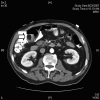Ileocecal valve lipoma with refractory hemorrhage
- PMID: 19366548
- PMCID: PMC3015905
Ileocecal valve lipoma with refractory hemorrhage
Abstract
Background: Lipomas are the most common benign mesenchymal tumors of the gastrointestinal tract, with the colon being the most prevalent site. Intestinal lipomas are usually asymptomatic. Tumors >2 cm in diameter may occasionally cause nonspecific symptoms, including change in bowel habits, abdominal pain, or rectal bleeding, but with resection the prognosis is excellent. Herein, we describe the case of an elderly male who presented with painless hematochezia.
Methods: Both colonoscopy and computed tomography of the abdomen and pelvis confirmed the presence of a mass near the ileocecal valve. Because of continuing bleeding, the patient required laparoscopic-assisted right hemicolectomy to resect the mass.
Results: Both gross and microscopic pathology were consistent with lipoma at the ileocecal valve.
Conclusion: Previous cases of ileocecal valve lipomas have been reported in the English literature, with the majority presenting as intussusception or volvulus. We present a rare case of an ulcerated ileocecal valve lipoma presenting as lower gastrointestinal bleeding that was treated successfully with laparoscopic resection.
Figures



Similar articles
-
Large ileocecal submucosal lipoma presenting as hematochezia, a case report and review of literature.Int J Surg Case Rep. 2015;10:1-4. doi: 10.1016/j.ijscr.2015.03.007. Epub 2015 Mar 7. Int J Surg Case Rep. 2015. PMID: 25770697 Free PMC article.
-
Colonic lipomas. Three surgical techniques for three different clinical cases.G Chir. 2012 Nov-Dec;33(11-12):420-2. G Chir. 2012. PMID: 23140930
-
[Intestinal occlusion due to a colonic lipoma. Apropos 2 cases].Minerva Chir. 1993 Sep 30;48(18):1035-9. Minerva Chir. 1993. PMID: 8290148 Italian.
-
[Gastrointestinal lipomas - report of three cases and a short review of the literature].Magy Seb. 2017 Jun;70(2):131-135. doi: 10.1556/1046.70.2017.2.4. Magy Seb. 2017. PMID: 28621187 Review. Hungarian.
-
[Ileocecal valve lipoma. Case report and review of the literature].Cir Cir. 2006 Jul-Aug;74(4):279-82. Cir Cir. 2006. PMID: 17022901 Review. Spanish.
Cited by
-
Colonic lipomas: our experience in diagnosis and treatment.Tech Coloproctol. 2011 Oct;15 Suppl 1:S71-3. doi: 10.1007/s10151-011-0736-y. Tech Coloproctol. 2011. PMID: 21887571
-
Ileocolic intussusception due to giant ileal lipoma: Review of literature and report of a case.Int J Surg Case Rep. 2012;3(8):382-4. doi: 10.1016/j.ijscr.2012.03.035. Epub 2012 Apr 17. Int J Surg Case Rep. 2012. PMID: 22622130 Free PMC article.
-
Large ileocecal submucosal lipoma presenting as hematochezia, a case report and review of literature.Int J Surg Case Rep. 2015;10:1-4. doi: 10.1016/j.ijscr.2015.03.007. Epub 2015 Mar 7. Int J Surg Case Rep. 2015. PMID: 25770697 Free PMC article.
-
Small bowel volvulus due to a large intestinal lipoma: A rare case report.Int J Surg Case Rep. 2020;77S(Suppl):S101-S104. doi: 10.1016/j.ijscr.2020.09.123. Epub 2020 Sep 25. Int J Surg Case Rep. 2020. PMID: 33041254 Free PMC article.
-
Solitary lipoma of ileocaecal valve mimicking Crohn's disease: A case report of a challenging diagnosis for a rare benign tumor of the intestinal tract.Int J Surg Case Rep. 2023 Sep;110:108696. doi: 10.1016/j.ijscr.2023.108696. Epub 2023 Aug 22. Int J Surg Case Rep. 2023. PMID: 37651809 Free PMC article.
References
-
- Katsinelos P, Paroutoglou G, Jouvaras G, et al. Lipohyperplasia of the ileocecal valve as a cause of intussusception. Acta Gastroenterol Belg. 2005;68:280–282 - PubMed
-
- Meshikhes AW, Al-Momen SA, Al Talaq FT, Al-Jaroof AH. Adult intussusception caused by a lipoma in the small bowel: report of a case. Surg Today. 2005;35:161–165 - PubMed
-
- Parmar JH, Lawrence R, Ridley NT. Submucous lipoma of the ileocaecal valve presenting as caecal volvulus. Int J Clin Pract. 2004;58:424–425 - PubMed
-
- Katsinelos P, Chatzimavroudis G, Zavos C, Paroutoglou G, Papaziogas B, Kountouras J. A novel technique for the treatment of a symptomatic giant colonic lipoma. J Laparoendosc Adv Surg Tech A. 2007;17:467–469 - PubMed
Publication types
MeSH terms
LinkOut - more resources
Full Text Sources
Medical
